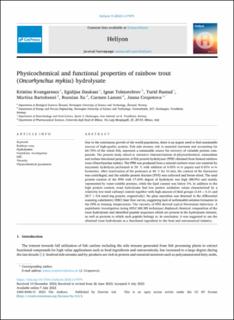| dc.description.abstract | Due to the continuous growth of the world population, there is an urgent need to find sustainable sources of high-quality protein. Fish side streams rich in essential nutrients and accounting for 60–70% of the whole fish, represent a sustainable source for recovery of valuable protein compounds. The present study aimed at extensive characterization of physicochemical, antioxidant and techno-functional properties of fish protein hydrolysate (FPH) obtained from farmed rainbow trout (Oncorhynchus mykiss). The FPH was produced from a minced rainbow trout raw material by enzymatic hydrolysis performed at 50 °C with addition of 0.05% w/w papain and 0.05% w/w bromelain. After inactivation of the proteases at 90 °C for 10 min, the content of the bioreactor was centrifuged, and the soluble protein fraction (FPH) was collected and freeze-dried. The total protein content of the FPH with 17.24% degree of hydrolysis was high (88.9%) and mainly represented by water-soluble proteins, while the lipid content was below 1%. In addition to the high protein content, trout hydrolysate had low protein oxidation values characterized by a relatively low total carbonyl content together with high amount of thiol groups (3.64 ± 0.31 and 20.7 ± 0.6 nmol/mg protein, respectively). No glass transition was detected in the differential scanning calorimetry (DSC) heat flow curves, suggesting lack of unfreezable solution formation in the FPH at freezing temperatures. The viscosity of FPH showed typical Newtonian behaviour. A peptidomic investigation (using HPLC-MS/MS technique) displayed chemical composition of the trout hydrolysate and identified peptide sequences which are present in the hydrolysate mixture, as well as proteins to which each peptide belongs to. In conclusion, it was suggested to use the obtained trout hydrolysate as a functional ingredient in the food and nutraceutical industry. | en_US |

